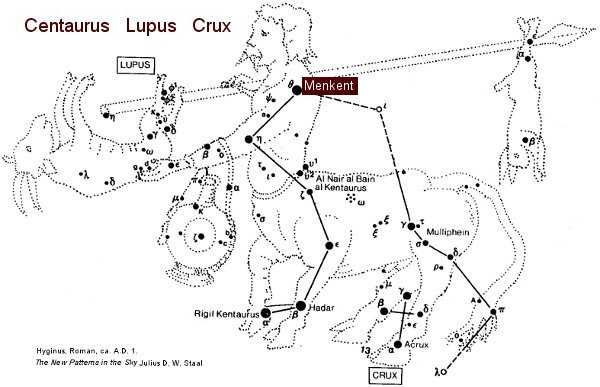| Fixed star: MENKENT | |
| Constellation: Theta (θ) Centaurus | |
| Longitude 1900: 10SCO55 | Longitude 2000: 12SCO18 |
| Declination 1900: -35.53′ | Declination 2000: -36.21′ |
| Right ascension: 14h 06m | Latitude: -22.04′ |
| Spectral class: G9 | Magnitude: 2.3 |
The history of the star: Menkent
from p.154 of Star Names, Richard Hinckley Allen, 1889.
[A scanned copy can be viewed on this webpage
Theta (θ) Centaurus, Menkent, is the third biggest star in the constellation Centaurus, a double and variable, 2.2 to 2.7 and 14.3, red and bluish star in the left shoulder of the Centaur.
The name Menkent appears to be derived from the Arabic word mankib (“shoulder”) and Kentaurus, the Latinized version of the Arabic word for “centaur”. [source
Star Names, Their Lore and Meaning, Richard Hinckley Allen, 1889].
The astrological influences of the constellation Centaurus
According to Ptolemy the stars in the human part of the figure are of the nature of Venus and Mercury, and the bright stars in the horse’s part of Venus and Jupiter. It is said to give hard-heartedness, inclination to vengeance, love of arms, strong passion, and an energetic nature. It may be connected with poisons. [Robson, p.37.]
The astrological influences of the constellation Centaurus given by Manilius:
"The Centaur, from his own nature assigns qualities to his progeny. Such a one will either urge on asses with the goad and yoke together quadrupeds of mixed stock or will ride aloft in a chariot; else he will saddle horses with a fighter or drive them into the fight [translator’s note; he will load horses with arms or drive them into arms, that is yoked to war-chariots].
"Another knows how to apply the arts of healing to the limbs of animals [translator’s note; these endowments reflect the identification of Centaurus as Chiron] and to relieve the dumb creatures of the disorders they cannot describe for his hearing.
"His is indeed a calling of skill, not to wait for the cries of pain, but recognize betimes a sick body not yet conscious of its sickness". [Astronomica, Manilius, 1st century A.D, book 5, p.329].
References:
Fixed Stars and Constellations in Astrology, Vivian E. Robson, 1923].
